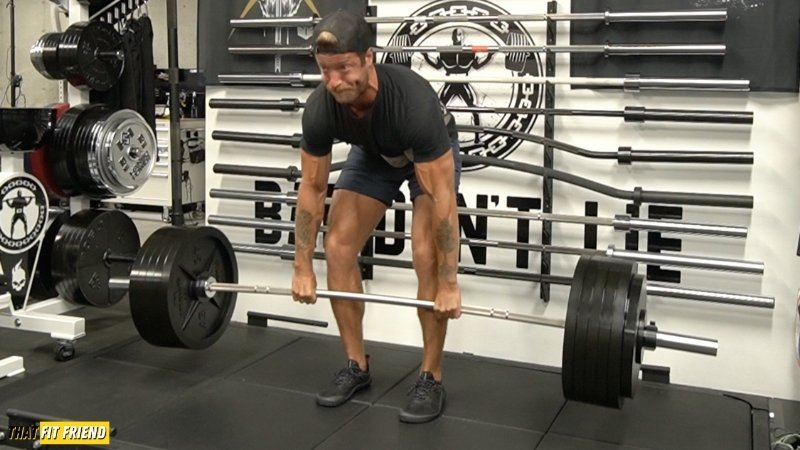Expert Reviewed By: Austin Current, CSCS, CISSN, Author and Strength Coach
The barbell good morning is often underutilized in the gym when it comes to building the posterior chain. I’ll often use good morning — most often with a safety bar if I have one — to build my glutes and erectors.
The amount of stretch that you can get on the glute max while leveraging the erectors for torso stability and extension are fantastic when you use good mornings with strategy and proper progressions.
The barbell good morning is an exercise where you place a barbell on the shoulders in a position that is between a high-bar back and low-bar squat and hinge backward with a neutral spine to place the load on the hamstrings, glutes, and erectors.
How To Perform Good Mornings
Step 1: Establish your setup
For the barbell good morning, you’ll want to place the barbell on the back in a position that is more comfortable for you. I like to use a hybrid position between a high-bar and low-bar back squat setup.
The big thing to remember is to not place the barbell on your neck or flare your elbows up trying to force a position. Excessive elbow flare can cause the torso to fold and take the load away from the glutes and hamstrings.
Step 2: Hinge and load the hips
Start your descent by pushing the hips back and loading them. Think as though there’s a string pulling the hips backward and “sit back” allowing the hamstrings and glutes to stretch. If you need to point the toes out and let your knees track accordingly.
Keep the elbows in a relatively consistent position and maintain a neutral torso as this will help facilitate a better stretch on the hamstrings and glutes while training the core and erectors.
Step 3: Bring the hips through and extend
Once you hit a range of motion that is either limited by your hamstrings’ abilities to stretch or you start to notice you’re folding your torso, you’ll start to stand back up with the weight.
As you ascend and extend the hips, think about driving the hips through as if a string is now pulling them forward. At lockout, squeeze your glutes to fully extend the hips, then sit back into the hole and start your next rep.
Barbell Good Morning Muscles Worked
If you’re programming the barbell good morning for hypertrophy specifically, then you’re likely performing them to grow your glutes and hamstrings. The loading style and deep hinge with the good morning can be great for building the posterior muscles.
As you perform barbell good morning more regularly, you’ll likely learn that your range of motion and loading style alter the muscles in which you “feel” you’re training. This is normal when you account for individual variances between forms.
Barbell Good Morning Benefits
So you’re on the fence about performing more barbell good mornings in your workout programs, below are three good morning benefits that I regularly language to my clients.
Benefit 1: Great for Building the Hamstrings and Glutes
In the barbell good morning you’ll be hinging with weight that is placed on the upper back and away from the hips. This can be useful for placing a greater stretch on the hamstrings and glutes.
This is why you’ll sometimes hear lifters say, “I feel more of a stretch in my hamstrings with good mornings than I do RDLs.” This is typically due to the loading style and how you’ve moved the weight further from the hips, AKA the fulcrum in this context.
On top of focusing on these muscles from a hypertrophy point of view, the good morning can also be great for strengthening these muscles with an eccentric bias, or a lengthened context.
Eccentric-focused training has a ton of benefits for both hypertrophy and strength. This type of training typically results in greater degrees of stress and can be useful for injury prevention as well.
Benefit 2: Carryover to Other Posterior-Focused Lifts
Another good morning benefit is that it’s an exercise that can have a ton of carryover to exercises like deadlifts. If a goal of yours is building a big deadlift and even a squat, then using accessories that will train the muscles needed for these movements can be useful.
On top of this, the good morning will build the hamstrings and glutes through lengthened contexts as discussed above and in order to have a strong deadlift you need to have a high capacity with these muscles.
If your hamstrings and glutes can tolerate high degrees of stress when lengthened then there’s a strong chance they’ll produce high amounts of force when contracting and shortening.
Benefit 3: Can Passively Train the Core and Erectors
Outside of building the hamstrings and glutes, the Barbell Good Morning can also help you improve your core strength in the context of strengthening your erectors and anterior core muscles.
The erectors will be working to prevent the torso from folding and flexing when doing reps and the core muscles like the rectus abdominis and obliques will be assisting with the stabilization of the torso.
Whether it’s for deadlifts, squats, clean & jerks, or sports where you want to maintain desired torso positions, the Barbell Good Morning can be a good tool for training your torso to remain rigid in different movement patterns.
Barbell Good Morning Mistakes
The barbell good morning can sometimes get a bad reputation as being an exercise that can be tough for beginners which can take away from its overall effectiveness. To get the most out of this exercise, you’ll want to avoid the two good morning mistakes below.
Mistake 1: Placing the Barbell On the Neck
One of the most common barbell good morning mistakes that I see beginners make is placing the barbell far too high on the back and even on the neck. While everyone’s barbell placement will be different you want to avoid placing it too high.
This can lead to unwanted stress on the neck when performing this exercise and can at times make it unsafe if you’re loading too heavily and not monitoring the range of motion you’re working through regarding your tissue capacities.
Mistake 2: Forcing Range of Motion
Another mistake that lifters can run into with the barbell good morning is forcing too much range of motion with their reps. When we do exercises like good mornings, we want to consider the “active” range of motion we’re working through.
If we’re exceeding this active range and the torso is starting to flex due to its compensating for a lack of hamstrings and hip mobility then we’re going to take away from the stress and work we’re trying to place on the desired muscles we want to train.
Barbell Good Morning Alternatives
If you don’t want to perform barbell good morning in your workout program but want to train a hinge movement pattern and build your hamstrings and glutes, then opting for the RDL can be a great good morning alternative.
In fact, when I’m coaching clients and they either don’t like good mornings or feel comfortable doing them, I’ll often program an RDL to achieve some of the same training benefits and adaptations.
Good Morning Alternative: Romanian Deadlift (RDL)
The Romanian deadlift will train a lot of the same muscles that the good morning will, however, instead of having the load displaced on the upper back you’ll be holding a weight in front of you.
This will generally make the Romanian deadlift a more beginner-friendly option and require less overall technique as you don’t need a strong rack position like in the good morning to be proficient.
Why the RDL Can Be a Good Morning Alternative
- With the RDL you’ll be training a similar movement pattern as the good morning meaning that you’ll be working a deep hip hinge and strengthening the muscles needed to be proficient with the hinge.
- In the RDL and good morning, you’ll be training the glutes, hamstrings, erectors, and core to various degrees, so from a hypertrophy standpoint both exercises can be useful for building the posterior chain.
- The RDL can be a great alternative if you don’t have a good rack position or feel uncomfortable with the barbell sitting on your back as you move into a deep hinge.
In most cases — despite most lifters having a preference — I recommend and coach lifters to familiarize themselves with both exercises as it can broaden your toolset for training the hip hinge movement pattern.
Frequently Asked Questions (FAQ)
Q:What muscles do the barbell good morning work?
Q:Are barbell good mornings effective?
Takeaway Thoughts
The barbell good morning can be a great exercise for training the glutes, hamstrings, erectors, and core. It can also be a useful exercise for strengthening and improving the hip hinge.
This exercise may not be the most beginner-friendly, but that doesn’t mean beginners should experiment and familiarize themselves with this movement pattern.
If you have additional questions about the barbell good morning or need help with your form, drop a comment below or reach out via Instagram (@jake_boly or @that_fit_friend).


















Add a Comment